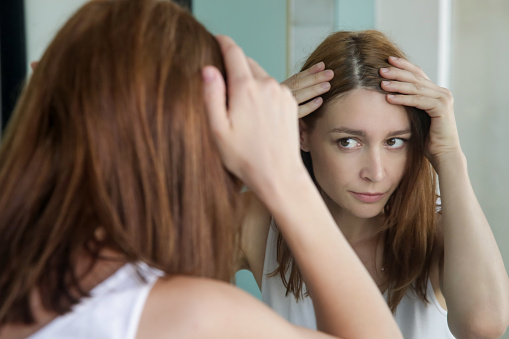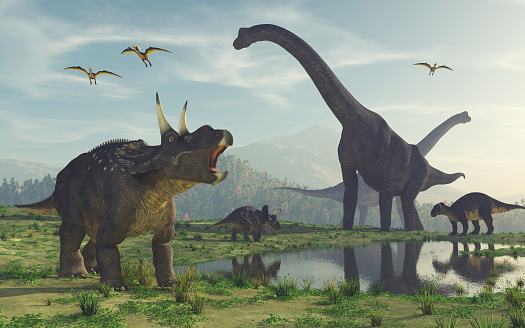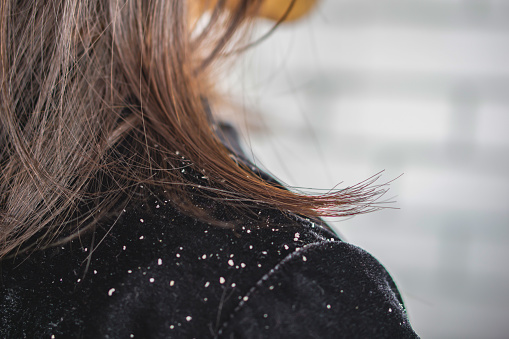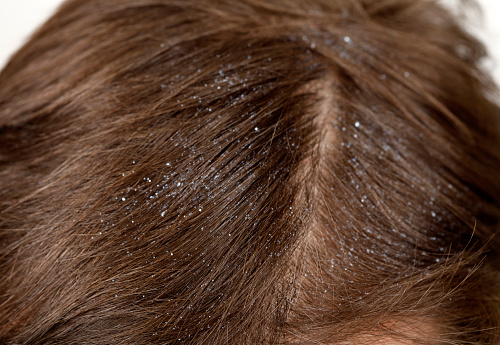What Actually Causes Dandruff?

A hundred and twenty-five million years ago in what is now China, dinosaurs walked the earth.
and a few species of small feathered dinosaurs climbed trees.
This is Sinornithosaurus.Although they couldn't truly fly, they could glide, which helped them evade predators and catch prey.What makes these dinosaurs unique is how well-preserved their fossils were.Normally when you find a dinosaur it's just a pile of bones and that's all there is.In between the feathers and the parts of the feather we saw little bits of skin And you can tell that they are skin - they're not just random bits of rock or broken up bone or something.
because they have a particular kind of cells within the structure.
which are just like the skin cells that we find in humans today.
Well, my first thought when I saw these was this is dinosaur dandruff,
and I was already planning to write the paper with the headline of we have discovered dinosaur dandruff,
I thought great.

So these dinosaurs may have had the first known case of dandruff.
But it certainly wasn't the last
Our skin cells are constantly replenishing themselves
in fact every second 500 new skin cells are created
and as they move up through the outer layer of your skin, the epidermis
They flatten out and harden until they fall off one by one
In fact over your lifetime you will shed about a hundred pounds of dead skin
But we don't really notice this because skin falls off in such tiny microscopic pieces
except for some people from some parts of the body skin comes off in larger flakes
typically from the skin under the hair the scalp and this is what's known as dandruff
Now around half of everyone on earth suffers from it.
So there are actually a lot of scientists who study this condition.
and I'm flying to Cincinnati to Head & Shoulders headquarters to visit their lab
Okay.
Do you need a break or something?
No, it's funny like 'cause I'm not really sure what I'm getting myself into right
No. No.
I am going to have my head swabbed
Mm-hmm. You are
What what is that all about? I mean, this is something you do to people all the time?
Oh, yeah. Every day.
-You're gonna cotton swab my scalp. --Yes
And we're looking for what?
यह भी पढ़ें -कम उम्र में बच्चों के सफेद बाल क्यों आते हैं | कारण और समाधान
So we are gonna be looking for the malassezia that is on your scalp.
Okay, so what do I need to do?
So I need you to have a seat here.
Let's see and I just put my head in here?
Yeah, put your head face forward. Okay. What I'm gonna do is I'm gonna part your hair.
So now I'm gonna take my swab I'm basically gonna grab off your scalp. Mm-hmm
So then what I do is I take this
These are sticky plates here that I can plate the malassezia on
and what I can do is I can add a stain
throw this under the microscope and this is the individual cells of malassezia here.
Malassezia globosa is a fungus that lives on your scalp
it thrives in the warm moist environment under your hair
and it is thought to be one of the causes of dandruff. So, how did my swab come back?
Well, I have malassezia living on my head.
This is actually what the fungus looks like. This is a lawn of the Malassezia globosa fungi.
You say a lawn. It's a lawn.
So basically you can see those little dots they're all individual colonies
and when they grow really close together like that, that's a lawn, Kind of like a bunch of grass
Now that I'm close to and actually smell it it smells like bread
Yeah, well, you know, it's a yeast
You know it's a free, living fungus just like the Saccharomyces that are used to make bread and make beer with
So, could you make bread with this?
Uh.. No. I wouldn't want to make bread with the yeast off of your scalp. Not right now.
-- Have you been tested? -- I've been tested. Yes. -- And what did it come out to?
I have a decent amount. So... But we all do. So...
It's on everyone's head.
It's on everyone's head as long as you have hair. --Right
But if everyone has Malassezia, why do only half of us get dandruff?
Well Malassezia lives on the oils called sebum secreted by your skin
The fungi release enzymes called lipases that break down fat molecules
Oh, so this is one of the lipases that Malassezia produces
So this is something that Malassezia uses to get food
But unfortunately as a byproduct of that it also attacks your scalp
because it produces free fatty acids that irritate the scalp
for some of us those molecules are perceived as invaders if you will
and all the defensive forces that we have will get turned on to repel essentially these invading molecules
and those defensive forces end up causing this collateral damage
that we interpret as an unhealthy scalp and dandruff

One of the scalps defenses is to speed up the turnover of skin cells
So instead of taking a month for skin cells to mature and reach the surface they take as little as seven days
When you know they get to the surface the adhesive function from one cell to the other hasn't been lost
And so they shed as these clumps of skin cells three or four hundred together, which we see as a dandruff flake
the dandruff flakes are just an indicator of a fundamentally unhealthy scalp underlying it
by any measure you can dream of making
Dandruff skin samples show elevated levels of inflammatory cytokines
Histamines which cause itching, and blood proteins on the surface of the scalp
Indicating that the skin is not acting as a good barrier between your insides and the outside world
But it goes even further than that down to the level of gene expression
Scientists took swabs from healthy scalps and dandruff scalps and then they extracted the RNA
Effectively markers of which genes are being expressed and how strongly
and then they compared the two groups
and they found that there were nearly 4000 genes which were systematically
either up-regulated or down-regulated in the dandruff scalps compared to the healthy scalps

for example immune and inflammatory response genes were up-regulated,
things like lipid metabolism were down regulated and it all kind of makes sense
But now that you know that there's a difference at the level of gene expression,
How do you actually treat dandruff?
So this is the the lawn of Malassezia.
This is the Malassezia with a spot of the Head & Shoulders active put on it
The Malassezia just doesn't grow where that Head & Shoulders active actually is
These active ingredients can be zinc pyrithione, selenium sulfide, or piroctone olamine.
They are controlling the metabolism of those Malassezia cells that are leading to irritating substances
so the idea is to suppress their bio activity to some extent
so that we're reducing the level of irritating substances on our scalp
that trigger the irritation and hyperproliferation and buried destruction that we talked about
now that we understand like these clusters in these genes signatures of dandruff is
Can we reverse these gene signatures if we treat with Head & Shoulders?
So this is the group of dandruff at baseline and these genes are all down-regulated
and then these genes are up-regulated
You can see if you treat with just a cosmetic shampoo that you really don't make a difference in those genes
But if you treat with Head & Shoulders after three weeks
This signature looks just like somebody who doesn't have dandruff.
And so you're looking at 3,700 genes have all clustered all on here,
And you're seeing them flip around. They're going from an unhealthy signature to a healthy signature
So Head & Shoulders reduces the Malassezia irritants on the scalp,
changing your scalp‘s response, and ultimately reducing skin flakes
So unlike dinosaurs, we don't have to live with dandruff
But in their case the presence of skin flakes reveals something important about their biology
They had evolved warm-bloodedness and hence feathers as a way to keep warm
But once they had feathers skin could no longer be shed in one piece like a snake but instead in tiny pieces
So in fact, although it's an amusing discovery it actually had quite an important or profound point
because it tells us that dinosaurs while commonly called reptiles
are on the side of the birds and the mammals in terms of physiology. They were definitely warm-blooded
Hey, I hope you learned something from watching this post I certainly learned a lot making it.
and if you want to find out more about Head & Shoulders research or about how to get rid of dandruff
I put a link to their website down
https://www.headandshoulders.com/en-us/healthy-hair-and-scalp/dandruff/get-rid-of-dandruff
so I want to say a big thanks to Head & Shoulders for supporting this episode of GetsetgoSCIENCE
and I want to thank you for washing. Or, reading.




Post a Comment